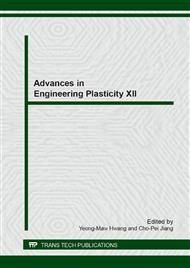[1]
S. Alexandrov, O. Richmond, Singular plastic flow fields near surfaces of maximum friction stress, Int. J. Non-linear. Mech. 36 (2001) 1-11.
DOI: 10.1016/s0020-7462(99)00075-x
Google Scholar
[2]
S.P. Moylan, S. Kompella, S. Chandrasekar, T.N. Farris, A new approach for studying mechanical properties of thin surface layers affected by manufacturing processes, Trans. ASME. J. Manuf. Sci. Eng. 125 (2003) 310-315.
DOI: 10.1115/1.1559161
Google Scholar
[3]
T.A. Trunina, E.A. Kokovkhin, Formation of a finely dispersed structure in steel surface layers under combined processing using hydraulic pressing, J. Mach. Manuf. Reliab. 37 (2008) 160-162.
DOI: 10.3103/s1052618808020118
Google Scholar
[4]
E. Lyamina, S. Alexandrov, D. Grabko, O. Shikimaka, The determination of the thickness of a layer of intensive deformations in the vicinity of the friction surface in metal forming processes, Key Eng. Mater. 345-346 (2007) 741-744.
DOI: 10.4028/www.scientific.net/kem.345-346.741
Google Scholar
[5]
S.E. Aleksandrov, D.Z. Grabko, O.A. Shikimaka, An approach to prediction of evolution of material properties in the vicinity of frictional interfaces in metal forming, J. Mach. Manuf. Reliab. 38 (2009) 277-282.
DOI: 10.3103/s105261880903011x
Google Scholar
[6]
S. Alexandrov, D. Vilotich, E.A. Liamina, L. Shidzhanin, Thickness of the layer of intensive plastic deformation in the vicinity of the friction surface during upsetting of a cylinder with flat dies, J. Appl. Mech. Techn. Phys. 52 (2011) 491-495.
DOI: 10.1134/s0021894411030217
Google Scholar
[7]
M. Thirumurugan, S.A. Rao, S. Kumaran, T.S. Rao, Improved ductility in ZM21 magnesium – aluminium macrocomposite produced by co - extrusion, J. Mater. Process. Technol. 211 (2011) 1637-1642.
DOI: 10.1016/j.jmatprotec.2011.05.005
Google Scholar
[8]
X. Li, G. Zu, M. Ding, Y. Mu, P. Wang, Interfacial microstructure and mechanical properties of Cu/Al clad sheet fabricated by asymmetric roll bonding and annealing, Mater. Sci. Eng. 529A (2011) 485-491.
DOI: 10.1016/j.msea.2011.09.087
Google Scholar
[9]
S. Alexandrov, N. Alexandrova, On the maximum friction law in viscoplasticity, Mech. Time-Depend. Mater. 4 (2000) 99-104.
Google Scholar
[10]
S. Alexandrov, N. Alexandrova, On the maximum friction law for rigid/plastic, hardening materials, Meccanica 35 (2000) 393-398.
Google Scholar
[11]
S. Alexandrov, V. Danilov, N. Chikanova, On the stagnation one in a simulation of axisymmetric pressure metal forming under creep, Mech. Solids. 35 (2000) 127 - 129.
Google Scholar
[12]
S. Alexandrov, E. Lyamina, Singular solutions for plane plastic flow of pressure-dependent materials, Dokl. Phys. 47 (2002) 308-311.
DOI: 10.1134/1.1477887
Google Scholar
[13]
S. Alexandrov, Singular solutions in an axisymmetric flow of a medium obeying the double shear model, J. Appl. Mech. Techn. Phys. 46 (2005) 766-771.
DOI: 10.1007/s10808-005-0133-2
Google Scholar
[14]
S. Alexandrov, G. Mishuris, Viscoplasticity with a saturation stress: distinguished features of the model, Arch. Appl. Mech. 77 (2007) 35-47.
DOI: 10.1007/s00419-006-0078-9
Google Scholar
[15]
S. Alexandrov, G. Mishuris, Qualitative behaviour of viscoplastic solutions in the vicinity of maximum-friction surfaces, J. Eng. Math. 65 (2009) 143-156.
DOI: 10.1007/s10665-009-9277-z
Google Scholar
[16]
S. Alexandrov, Y.-R. Jeng, Singular rigid/plastic solutions in anisotropic plasticity under plane strain conditions, Cont. Mech. Therm. 25 (2013) 685-689.
DOI: 10.1007/s00161-013-0304-y
Google Scholar
[17]
S. Alexandrov, Y. Mustafa, Singular solutions in viscoplasticity under plane strain conditions, Meccanica 48 (2013) 2203-2208.
DOI: 10.1007/s11012-013-9736-5
Google Scholar
[18]
J.R. Rice, Plane – strain slip line theory for anisotropic rigid/plastic materials, J. Mech. Phys. Solids 21 (1973) 63-74.
DOI: 10.1016/0022-5096(73)90030-6
Google Scholar
[19]
I.F. Collins, S.A. Meguid, On the influence of hardening and anisotropy on the plane – strain compression of thin metal strip, Trans. ASME J. Appl. Mech. 44 (1977) 271-278.
DOI: 10.1115/1.3424037
Google Scholar
[20]
S. Alexandrov, The strain rate intensity factor and its applications: a review, Mater. Sci. Forum. 623 (2009) 1-20.
Google Scholar


